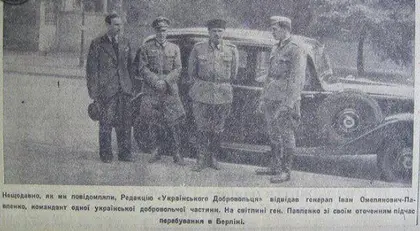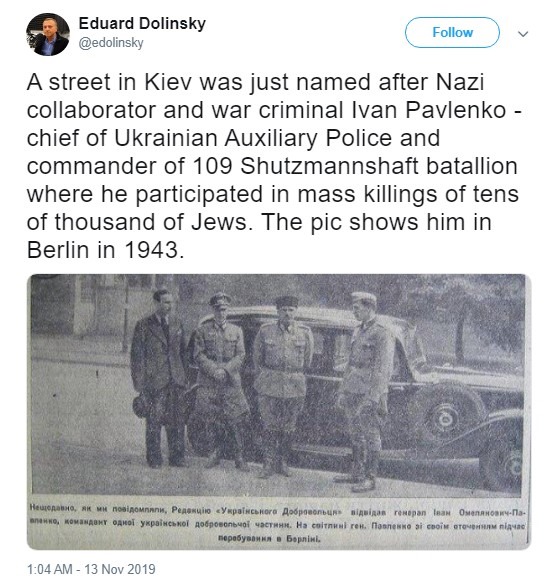Major international media outlets spread false news about the renaming of a Ukrainian street after a Nazi.
On Nov. 13 Eduard Dolinsky, the director of the Ukrainian Jewish Committee, tweeted “A street in Kiev was just named after Nazi collaborator and war criminal Ivan Pavlenko – chief of Ukrainian Auxiliary Police and commander of 109 Shutzmannshaftbatallion where he participated in mass killings of tens of thousand of Jews. The pic shows him in Berlin in 1943.”
JOIN US ON TELEGRAM
Follow our coverage of the war on the @Kyivpost_official.
The tweet racked up 253 likes and 302 retweets and was quickly used as a source in an Associated Press story that was then reposted by the New York Times and The Times of Israel. Dolinsky since removed the tweet.
Ukrainian officials posted an announcement on Nov. 14 to prove Dolinsky’s claim was fake. The new street is being named in honor of Viktor Pavlenko, a victim of the Holodomor, not Ivan, who was a Nazi collaborator.
Viktor Pavlenko was a Ukrainian military and political leader who was born in 1886. He died in 1932, more than a decade before the photo that Dolinsky shared was taken. Viktor died in the Holodomor, the genocide ordered by Stalin to starve Ukrainians into submission to the Soviets and abandonment of independence and private land ownership. The famine killed at least four million Ukrainians. Russia still refuses to acknowledge the Holodomor as genocide while Ukraine has mounted an international fight for its recognition.
Ivan Pavlenko, meanwhile, was a military officer for many years before forming the 109 Schutzmannschafts Battalion, a security unit of the Nazi German auxiliary security police. Ivan had served as a Russian officer in the imperial Russian army during the Russian-Japanese war and as a Ukrainian officer in World War I. In the summer of 1941, he formed the 109 battalion composed of volunteers and Soviet prisoners of war. After the war, Ivan moved to the United States and lived in Chicago until his death.
The auxiliary police registered Jews living in the Reich Commissariat, guarded the ghetto, delivered prisoners to places of execution and suppressed anti-Nazi movements. These units were responsible for the deaths of thousands of Jews.
On Nov. 15, the Associated Press quickly corrected its article and Dolinsky posted an apology on Facebook, “I apologize for hurrying and without understanding, I spread the wrong information.”
However, Dolinsky was not going to let the city council off the hook, adding, “Nevertheless, my post was inaccurate only in part of Pavlenko Street. The second street is to be named after Nazi collaborator Nil Khasevich and the writer Ulas Samchuk worked on a Nazi newspaper Volyn, drawing anti-Semitic cartoons”
He did not post his apology on Twitter. Instead, he just retweeted the corrected article from AP to his 2,600+ followers. He deleted the mistaken tweet three hours after his apology post.
While calling out Nazi collaborators is important, the episode underscores the dangers of how quickly fake news can spread in the internet age.
This report played into one of the Kremlin’s favorite false propaganda storylines about Ukraine: That it is a country full of neo-Nazis.
Though in comparison with Russian dictator Vladimir Putin, who has been in power for 20 years, Ukraine is a pluralistic and tolerant democracy open to the outside world with mutual visa-free regimes with dozens of nations.
Russia has taken advantage of social media to spread misinformation time and time again. A study by Princeton’s Empirical Studies of Conflict Center found that Russia accounts for 72% of foreign disinformation operations.
You can also highlight the text and press Ctrl + Enter





